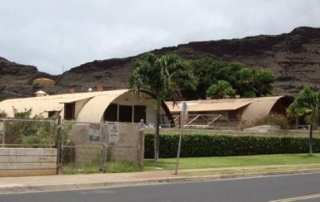The Kamaboko House
By Tonia Moy, with additional research by Don Hibbard All photos courtesy of Fung Associates For many growing up in rural Hawai‘i, the “Quonset Hut” or the “kamaboko house” brings back memories of peering over walls not conforming to the arched ceiling, running through the house from end to end or crouching to use the toilet nestled in the corner of the curved wall. The name “Quonset hut” derives from the place of initial production, Quonset, Rhode Island, a small peninsula in Narragansett Bay that retained its Native American place name aptly meaning “small long place.” The Quonset hut was developed by the U.S. Department of Defense to be quickly erected almost anywhere in the world. Approximately 155,000 of various size and modifications were constructed before and during the massive World War II build up of facilities. The efficiency and versatility of the Quonset Hut was unparalleled, having the smallest shipping cube per man housed than any other temporary hut, including canvas tents with wood frames and floors. It was promoted as shelter that could be constructed in a day by ten men with no special construction skills. Following the war, Honolulu faced a significant housing shortage, as did the United States as a whole and the Navy had an excess of Quonset Huts. Several building supply companies such as Dan’s Lumber Yard, Kilgo’s Hardware, Tajiri Building Supplies and Frank Fasi’s Supply Company would obtain the government contract to salvage the huts and then sell for parts or in whole. The most famous of the building supply company owners was Frank Fasi, who started his contracting firm in 1946 after moving here to work for the Army Corps of Engineers and ran his salvage [...]


